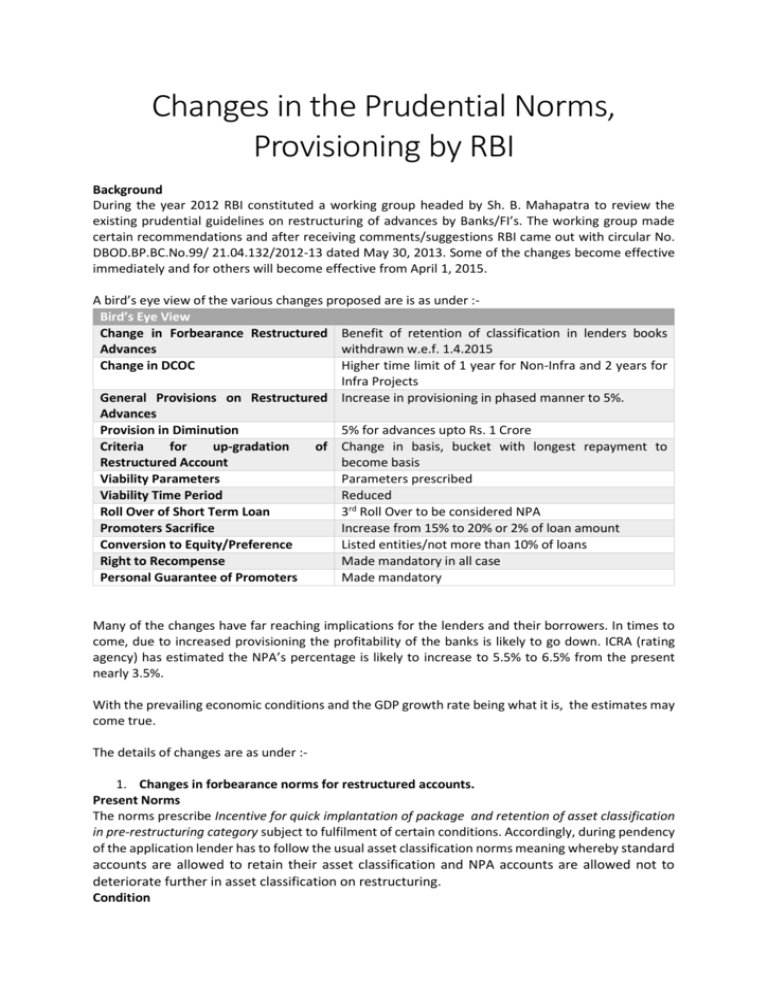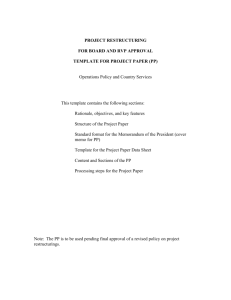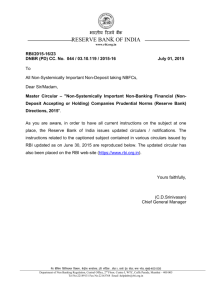Changes in the Prudential Norms, Provisioning by RBI
advertisement

Changes in the Prudential Norms, Provisioning by RBI Background During the year 2012 RBI constituted a working group headed by Sh. B. Mahapatra to review the existing prudential guidelines on restructuring of advances by Banks/FI’s. The working group made certain recommendations and after receiving comments/suggestions RBI came out with circular No. DBOD.BP.BC.No.99/ 21.04.132/2012-13 dated May 30, 2013. Some of the changes become effective immediately and for others will become effective from April 1, 2015. A bird’s eye view of the various changes proposed are is as under :Bird’s Eye View Change in Forbearance Restructured Benefit of retention of classification in lenders books Advances withdrawn w.e.f. 1.4.2015 Change in DCOC Higher time limit of 1 year for Non-Infra and 2 years for Infra Projects General Provisions on Restructured Increase in provisioning in phased manner to 5%. Advances Provision in Diminution 5% for advances upto Rs. 1 Crore Criteria for up-gradation of Change in basis, bucket with longest repayment to Restructured Account become basis Viability Parameters Parameters prescribed Viability Time Period Reduced Roll Over of Short Term Loan 3rd Roll Over to be considered NPA Promoters Sacrifice Increase from 15% to 20% or 2% of loan amount Conversion to Equity/Preference Listed entities/not more than 10% of loans Right to Recompense Made mandatory in all case Personal Guarantee of Promoters Made mandatory Many of the changes have far reaching implications for the lenders and their borrowers. In times to come, due to increased provisioning the profitability of the banks is likely to go down. ICRA (rating agency) has estimated the NPA’s percentage is likely to increase to 5.5% to 6.5% from the present nearly 3.5%. With the prevailing economic conditions and the GDP growth rate being what it is, the estimates may come true. The details of changes are as under :1. Changes in forbearance norms for restructured accounts. Present Norms The norms prescribe Incentive for quick implantation of package and retention of asset classification in pre-restructuring category subject to fulfilment of certain conditions. Accordingly, during pendency of the application lender has to follow the usual asset classification norms meaning whereby standard accounts are allowed to retain their asset classification and NPA accounts are allowed not to deteriorate further in asset classification on restructuring. Condition The restructuring package is implemented within 90 days of receipt of application, lender allowed to retain the present classification for Non-CDR cases. In case of CDR cases time limit is 120 days. Benefit is also available to projects under implementation (Infrastructure and others) which have passed their ‘Date of Commencement of Commercial Operations’ [DCCO]. Change With the recent circular the existing asset classification benefits available on restructuring on fulfilling certain conditions will be withdrawn for all restructured accounts effective from April 1, 2015 with the exception of provisions related to changes in DCCO in respect of infrastructure as well as non-infrastructure project loans. Implication of the change It implies that a standard account on restructuring (for reasons other than change in DCCO) would be immediately classified as sub-standard on restructuring as also the non-performing assets, upon restructuring, would continue to have the same asset classification as prior to restructuring and slip into further lower asset classification categories as per the extant asset classification norms with reference to the pre-restructuring repayment schedule. This will increase substantially the provisioning for the Banks/FI’s. Date of implementation for this change is April 1, 2015 Incidentally vide point no. 8 of the same circular RBI has given incentive for quick implementation of restructuring package for non-CDR restructurings. If the restructuring package is implemented within 120 days (90 days as per earlier guidelines) of receipt of application, lender allowed to retain the present classification for Non-CDR cases. This will continue to apply till new norms kick in i.e. upto 31.3.2015. 2. Change in Date of Commencement of Commercial Operations This change pertains to project under implementation which are classified into two categories viz. a. Infrastructure projects b. Non infrastructure projects At the time of appraisal/financial closure a date for Commencement of Commercial Operations (DCOC) is specified. Due to uncertainties involved in implementation, at times, the project is not able to commence commercial operations by the appointed date. In terms of the earlier guidelines, if the project is unable to commence commercial operations as per the DCOC specified, the account was to be downgraded to NPA. The period envisaged was 6 months for non-infrastructure projects and 2 years for infrastructure projects. The lender on request of the borrower and upon satisfaction of certain terms and conditions as laid down under circular no. DBOD.No.BP.BC.9 /21.04.048/2012-13 dated July 2, 2012 could extend the DCOC and retain the present status of the account. RBI in its present circular has made following changes in this respect :- a. For other projects banks can extend the prescribed period of ‘six months from the original DCCO’ to ‘one year from the original DCCO’ within which a non-infrastructure project will have to commence commercial operation for complying with the provisions in this regard. As a consequence of the above, if the delay in commencement of commercial operations extends beyond the period of one year from the date of completion as determined at the time of financial closure, banks can prescribe a fresh DCCO and retain the “standard” classification by undertaking the restructuring of accounts in accordance with the provisions in this regard provided that the fresh DCCO does not extend beyond a period of 2 years from the original DCCO. This will help those borrowers and banks which are stuck up with projects which are suffering from time over run. b. The circular specifically provides that mere extension of DCCO would not be considered as restructuring, if the revised DCCO falls within the period of two years and one year from the original DCCO for infrastructure projects and non-infrastructure projects respectively. In such cases the consequential shift in repayment period by equal or shorter duration (including the start date and end date of revised repayment schedule) than the extension of DCCO, would also not be considered as restructuring provided all other terms and conditions of the loan remain unchanged. As such project loans will be treated as standard assets in all respects. c. As regards Commercial Real Estate Projects (CRE) mere extension of DCCO even in the case of CRE projects would not be considered as restructuring, if the revised DCCO falls within the period of one year from the original DCCO and there is no change in other terms and conditions except possible shift of the repayment schedule and servicing of the loan by equal or shorter duration compared to the period by which DCCO has been extended. d. PPP Projects :- PPP Projects where the DCCO is extended due to shift in appointed date will not be considered restructured provided followings are satisfied :i. Project is an infrastructure project under PPP model awarded by a public authority; ii. The loan disbursement is yet to begin; iii. The revised date of commencement of commercial operations is documented by way of a supplementary agreement between the borrower and lender; and iv. Project viability has been reassessed and sanction from appropriate authority has been obtained at the time of supplementary agreement. v. Viability is reassessed and the Board of the bank is satisfied in this regard. e. The circular reiterates that norms regarding not treating an account as a restructured account on account of any change in the repayment schedule of a project loan caused due to an increase in the project outlay on account of increase in scope and size of the project, subject to certain conditions, will continue to remain effective. 3. General Provisions on Restructured Advances As per the present guidelines banks are required to make a provision of 2.75% on restructured standard accounts for different periods depending on the way an account is classified as restructured standard account, i.e. either abinitio or on upgradation or on retention of asset classification due to change in DCCO of infrastructure and noninfrastructure projects. Such provisioning is enhanced to 5% in phased manner by RBI as per table given below :Effective date Provisioning % 31/03/2014 (spread over 4 quarters of 13-14) 3.5 31/03/2015 (spread over 4 quarters of 14-15) 4.25 31/03/2016 (spread over 4 quarters of 15-16) 5.00 4. Provision for diminution in fair value of restructured advances a. The current instructions regarding calculation of diminution in the fair value of restructured advances will continue. b. Where the total dues to banks are less than Rs. 1 Crore, the diminution may be taken as 5% and may be provided on long term basis. This was earlier available to small/rural branches. 5. Criteria for up-gradation of account classified as NPA on restructuring In terms of the existing guidelines, all restructured accounts which have been classified as NPA and which have been restructured, are eligible for up-gradation to the ‘standard’ category after observing satisfactory performance during the specified period. The specified period in this regard means a period of one year from the date when the first payment of interest or instalment of principal falls due under the terms of restructuring package. Satisfactory performance during the specified period means adherence to the following conditions during that period:a. Non-Agricultural Cash Credit Accounts In the case of non-agricultural cash credit accounts, the account should not be out of order any time during the specified period, for a duration of more than 90 days. In addition, there should not be any overdues at the end of the specified period. b. Non-Agricultural Term Loan Accounts In the case of non-agricultural term loan accounts, no payment should remain overdue for a period of more than 90 days. In addition there should not be any overdues at the end of the specified period. c. All Agricultural Accounts In the case of agricultural accounts, at the end of the specified period the account should be regular. It is well known that when the borrower is facing financial difficulties there is payment pressure. This is the primary reason why the account is classified as NPA in the books of the lender. In order to reduce the financial burden of the borrower, the existing loans under the restructuring exercise are broken into different packets/buckets and different rates of interest and repayment periods are prescribed, based upon the past/future cash flows of the borrower. We take an example of A Ltd. a borrower having credit facilities from 2 banks aggregating to Rs. 75 Crores. The pre-restructuring debt of A Ltd. is as under :Nature of Loan ----(Rs. Cr.) Bank X Bank Z Total Term Loan Cash Credit Unpaid Interest Total 17 18 2 37 18 19 1 38 35 37 3 75 A Ltd. is facing financial difficulties and its account with both the banks has turned NPA as on 31.3.2012. Upon request of A Ltd., both the banks agree to a restructuring package with cutoff-date as 31.3.12. The loans are reclassified as under :Nature of Loan ----(Rs. Cr.) Term Loan Cash Credit WCDL Zero Coupon Loan Total Bank X 10 10 8 9 37 Bank Z 10 10 9 9 38 Total 20 20 17 18 75 As per the package, the loans will have following terms :a. Term Loan i. Interest @ 10%, ii. Interest payments to commence immediately, iii. Repayment in 28 equal quarterly instalments commencing from 1.4.2014. b. Cash Credit i. Interest @ 8% ii. Interest payment to commence immediately. c. Working Capital Demand Loan (WCDL) i. Interest @ 10%, ii. Interest payment to commence from 1.4.2014 iii. Repayment in 28 equal quarterly instalment commencing from 1.4.2015 d. Zero Coupon Loan i. Repayment with yield of 8% in 4 equal quarterly instalments in the year 2021 As can be noticed from the above, the outgo for A Ltd. during FY13 is on account of interest payment for Cash Credit and Term Loan accounts aggregating to Rs. 3.60 Crores. Supposing the company performs as per the package and pays the interest which falls due during FY13. As per the present guidelines, since the company has performed satisfactorily during the specified period, the account of the company with the lenders will be upgraded as on 31.3.13. The above way of bifurcation of accounts into different baskets with different repayment structure and interest rates is a very common practice. The underlying object is to be provide borrower relief. The effect of the above practice was that in some cases of restructuring with moratorium on payment of principal as well as major portion of interest, the accounts were upgraded on the basis of payment of interest on only a small portion of the debt, though such account may have inherent weakness as payment of interest only on a small portion of the debt is presently the yard stick for ‘satisfactory performance’ during ‘specified period’. Vide the new circular RBI has redefined the ‘specified period’. Specified period is now redefined as a period of one year from the commencement of the first payment of interest or principal, whichever is later, on the credit facility with ‘longest period of moratorium under the terms of restructuring package’. As a result of above, standard accounts classified as NPA and NPA accounts retained in the same category on restructuring by the bank should be upgraded only when all the outstanding loan/facilities in the account perform satisfactorily during the ‘specified period’, i.e. principal and interest on all facilities in the account are serviced as per terms of payment during that period. This is a major departure from the existing guidelines. This change is going to affect all the present and future restructured accounts. In view of the author, the proposed guidelines will act as a deterrent for the banks for restructuring of borrower accounts. The incentive presently available to the lender by way of up-gradation of account in the books of the lender will be elongated and will available to them after much longer period. In the example given above, the borrower account can be only upgraded in the year 2021 when the Zero Coupon Loan is repaid with the specified yield. In view of the author, all the existing restructured accounts (which were NPA before restructuring) will suffer the fate. This will also increase the provisioning in the books of the lenders and impact their bottom lines. 6. Benchmarks on Viability Parameters As per the present guidelines, financial viability of the borrower is to be established before the account is restructured and there exists a reasonable certainty of repayment/interest payments as per the package. The various benchmarks for viability were left by RBI to the banks. As such at present the various benchmarks based on which viability was measured were set by the banks and not by the RBI. Through the present circular certain broad benchmarks have been prescribed by the RBI. The broad benchmarks prescribed are as under :i. Return on capital employed should be at least equivalent to 5 year Government security yield plus 2 per cent. ii. The debt service coverage ratio should be greater than 1.25 within the 5 years period in which the unit should become viable and on year to year basis the ratio should be above 1. The normal debt service coverage ratio for 10 years repayment period should be around 1.33. iii. The benchmark gap between internal rate of return and cost of capital should be at least 1 per cent. iv. Operating and cash break even points should be worked out and they should be comparable with the industry norms. v. Trends of the company based on historical data and future projections should be comparable with the industry. Thus behaviour of past and future EBIDTA should be studied and compared with industry average. vi. Loan life ratio (LLR), as defined below should be 1.4, which would give a cushion of 40% to the amount of loan to be serviced. LLR = Present value of total available cash flow (ACF) during the loan life period (including interest and principal) Maximum amount of loan Leverage given to banks to adopt these benchmarks with appropriate adjustments. 7. Viability Time Period The present guidelines prescribe that the unit should become viable within a period of 10 years to Infrastructure projects and 7 years for non-infrastructure projects. Henceforth the time limit is reduced to 8 years and 5 years, respectively. Thus the time for attaining viability is reduced. 8. Roll over of Short Term Loans Short Term Loans are many a times allowed facility of Roll Over. Conditions have now been attached to such Roll Over. They are i. ii. iii. iv. Proper pre-sanction assessment is made, Roll-over is allowed based on the actual requirement of the borrower, No concession has been provided due to credit weakness of the borrower, In case account is rolled-over more than 2 times, then third roll-over onwards the account would have to be treated as a restructured account. 9. Promoters Sacrifice One of the conditions for eligibility for regulatory asset classification benefit on restructuring is that promoters' sacrifice and additional funds brought by them should be a minimum of 15 per cent of banks' sacrifice. The term 'bank's sacrifice' means the amount of "erosion in the fair value of the advance". It is also prescribed that promoters’ sacrifice may be brought in two instalments and it may be brought in different forms as indicated therein. As per the recent circular, the promoters sacrifice has been enhanced. The revised guidelines prescribe that promoters’ sacrifice and additional funds brought by them should be minimum of 20 per cent of banks’ sacrifice or 2 per cent of the restructured debt, whichever is higher. This is minimum contribution which the lenders must insist, they are free to insist for a higher contribution from the promoters. 10. Conversion of loan to Preference Shares/Equity Shares Present guidelines do not put a cap on conversion of loans to equity or preference shares. The restrictions are contained in the SEBI guidelines and the BR Act. Through the present circular RBI has put certain restrictions they are :a. Conversion to be done only as last resort. b. Conversion be restrained to 10% of the restructured debt. c. Conversion to equity should be done only in case of listed companies. 11. Right to Recompense Presently right to recompense is restricted to CDR cases. The formula for calculation of recompense is left to the CDR Standing Group. The recent circular has made right to recompense mandatory in case of all restructuring exercises. The circular recommends that 75 per cent of the amount of recompense calculated should be recovered from the borrowers and in cases of restructuring where a facility has been granted below base rate, 100 per cent of the recompense amount should be recovered. 12. Personal Guarantee of Promoters The recent circular desires that in case of all restructured advances, personal guarantee of the promoters should be obtained in order to get the benefits of asset classification. Personal guarantee will ensure promoters’ “skin in the game” or commitment to the restructuring package. Wherever a corporate is promoter, corporate guarantee should be obtained.






